By
Prof. A. R. Ghode, Mr.Kukkar Paresh K.
Amrutvahini College of Engineering, Sangamner
Abstract
Tidal Energy or tidal power achieved by capturing the energy contained in moving water mass due to tides. Two types of tidal energy can be extracted: kinetic energy of current between ebbing and surging tides and potential energy of currents between high and low tides. The formal method – generating energy from tidal current – is considered much more feasible today than building ocean-based dams or barrages, and many coastal sites worldwide are being examined for their suitability to produce tidal energy. Tidal power is reliable predictable (unlike wind energy and solar power).
1.0 INTRODUCTION
As a brief introduction, I would like to explain my interests in studying Tidal Power as a means for generating reliable, carbon-free electricity.
It’s a plain fact that we are in a world where almost 80 percent of the demanding energy is furnished by sources such as natural gas, coal, or oil, which are quickly being depleted as well as being environmentally unfriendly. We have also developed some destructive processes such as the nuclear power plants, which would also be a sword of Damocles of all human beings. Luckily, we have already realized the importance of making an enormous change in our way of life and our way of using the energy, so looking for renewable resources to substitute current ones is much urgent for us. Tidal power is classified as a renewable energy source, because tides are caused by the orbital mechanics of the solar system and are considered inexhaustible within a human timeframe. Energy from tidal power is also a form of pollution free energy, which has a lot of potential. Though these potentials have not been fully realized yet, we can’t deny the advantage of such kind of a renewable energy. This paper gives some basic introductions of tidal power and the basic principle of how tidal generator works, and it also focuses on the development of tidal power energy of the world.
1.1 History(Eling Mill)
The Eling Mill, located in the south of England, is an excellent demonstration of how tidal mills may have worked over a thousand years ago. Eling Mill is a tidal powered flour mill and has been for many centuries. The mill was included in the domes day survey in1086, which took an inventory of owned what throughout the country on England. Originally the Mill was owned by the King because Eling was a royal manor, but King John sold the mill in the early 13th century. Historically, a tide mill was built on the site of a former mill in 1419 by Thomas Millington. Most of the grain that was milled at the site was not locally produced. Oftentimes, grain from several hundred miles around the coast was brought to the Mill by ship. At maximum output the mill would have produced four tons of flour each day
The Mill that currently occupies the site was reconstructed in the 1770s after several floods damaged the millhouse and the dam. It has two separate wheels, each with its own machinery which allows two different milling operations to occur in the same mill. In 1382, the Mill was purchased by the Bishop of Winchester and was given to Winchester College as a means to fund the college. Winchester College owned the Mill for over five hundred years, until 1975 when the New Forest District Council purchased it. Although the Eling Mill has been rebuilt quite a few times, it has basically operated in the same manner for over 900 years.
In the late 1800s, large steam-powered roller mills were built throughout the country to mill imported grain, usually from Canada. Many of the tidal mills were forced to close, and only several of these historic sites remain today. The local governing body, the New Forest District Council, restored the mill and reopened it in 1980. Eling is unique in that it remains a functional mill that produces flour.
1.2 Need of Tidal Energy
Aside from my fascination with the Norfolk Tides minor league baseball team, I knew nothing about this renewable source of energy and wanted to discover the science behind it, and the potential of harnessing the crash of the ocean. Both old school and cutting edge, tidal power is always offered as an alternative energy source, but is largely ignored in favor of wind and solar power. However, renewable energies are like Slim-fast cookies: using less polluting technologies to produce our power does not mean we can over-consume. As a replacement to traditional fossil fuels, tidal power can make a significant contribution on a local and regional scale to the power grid of several countries. Although there are significant environmental impacts from large-scale tidal schemes, there are also existing environmental impacts from coal power plants, oil refineries, etc. so I believe we should educate ourselves about the costs and benefits of a wide variety of energy sources. Different localities will be impacted in unique ways, so what is true for one community may not be true for another. We should not let indecision over environmental concerns stagnate possibilities for cleaner energy, but let it urge us to look for the best solution available to us at the current level of technology and society. Cooperative and democratic governing structures will enable clear communication between the various stakeholders: from citizens to cabinet members, we will be more flexible and willing to work together not only to create new power schemes, but also to allocate resources more equitably.
Every land is surrounded by copious amounts of tidal water. The periodic differential water leveling created by lunar/earth interactions creates a predictable system capable of generating respectable amounts of kinetic energy through artificial damming. Meanwhile, offshore, strong underwater currents are potential sources for copious amounts of energy through the use of ocean floor turbines. Interestingly, the UK has major advantages in both systems over the US; the waters around the UK have substantially greater tidal differences between low and high tide levels and a variety of cool water channels that house persistent ocean currents. Ironically, at the same time, the US embraces the idea of renewable energy through such systems much more firmly than the UK. Not to be taken less seriously is the potential for wave energy to one day be the leader in renewable energy systems in both countries. This document will explore the possibilities of all three energy systems while keeping in mind the relatively different general attitudes toward each nation’s waterways.
1.3 Objectives
1. Utilize an advanced ocean circulation numerical model (ROMS) to predict tidal currents.
2. Validate the velocities and water levels predicted by the model with available data.
3. Compute the tidal harmonic constituents for the velocities and water levels.
4. Build a GIS database of the tidal constituents.
5. Develop GIS tools for dissemination of the data.
a. A filter based on depth requirements.
b. Compute current velocity histograms based on the tidal constituents.
c. Compute the available power density (W/m2) based on the velocity histograms.
d. Compute the total available power within arrays based on turbine performance parameters.
6. Develop a web based interface for accessing the GIS database and using the GIS tools.
2.0 METHODOLOGY
2.1 Turbine Types
2.1.1 Waterwheel Turbines
2.1.1.1 Undershot Wheel
Waterwheels were used from the invention of the tidal mill until the industrial revolution.

The first turbine used was the basic undershot waterwheel. This is probably the oldest type of waterwheel dating back over two thousand years. It is mounted vertically on a horizontal axle and it has flat boards located radially around a rim. It is turned by water flowing under the wheel and striking the boards.
2.1.1.2 Overshot Wheel
The second type of turbine used was an overshot waterwheel. The overshot wheel is much more efficient than the undershot wheel. Again, this turbine is mounted vertically on a horizontal axle, but the overshot wheel has buckets mounted around the rim.
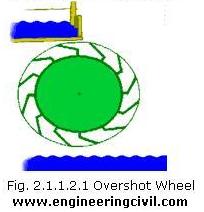
Water from above flows into the buckets, causing one side of the wheel to be heavier. Gravity then acts on the heavier side causing the wheel to turn.
2.1.1.3 Breast-shot Wheel
The third type of turbine used was a breast-shot waterwheel. This type of wheel was developed in the late middle ages and combines the previous two waterwheels. It has buckets on a rim that face the opposite direction of the buckets on the overshot wheel. Water then fills the buckets at the middle of the wheel. Again, gravity acting upon the water in the buckets causes the wheel to turn.

2.1.2 Tidal Steam Turbine
These are close in concept to traditional windmills operating under the sea and have the most prototypes currently operating. The turbines feature a rotor section that is approximately 15 meters in diameter with a gravity base which is slighter larger than this to support the structure. The turbines will operate in deep water well below shipping channels. Each turbine is forecast to produce energy for between 300 and 400 homes.
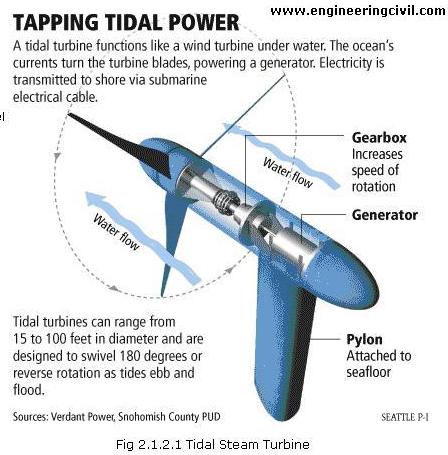
It can be floated out to site, installed without cranes, jack-ups or divers, and then ballasted into operating position. At full scale the Triton 3 in 30-50m deep water has a 3MW capacity, and the Triton 6 in 60-80m water has a capacity of up to 10MW, depending on the flow. Both platforms have man-access capability both in the operating position and in the float-out maintenance position.
2.1.3 Recent Turbine Developments
Bulb turbines incorporated the generator-motor unit in the flow passage of the water. These turbines are used at the La Rance power station in France. The main drawback is that water flows around the turbine, making maintenance difficult.
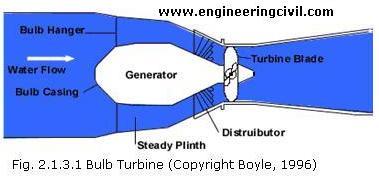
Rim turbines allow the generator to be mounted in the barrage, at right angles to the turbine blades. It is difficult to regulate the performance of these turbines and it is unsuitable for use in pumping.
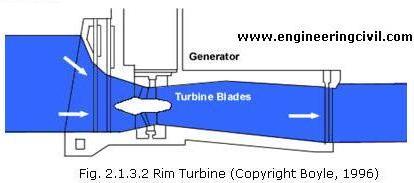
Once the development of more tidal schemes occurs, additional types of turbines will be tested and implemented.
2.3 Construction
In terms of construction, caissons, which are large units of concrete or steel that, are manufactured at shore-based construction yards are delivered to water sites by barges and then positioned by cranes to allow for the structures to correctly settle on the marine floor. Overall, this is an extremely expensive process. Another method calls for constructing diaphragm walls of reinforced concrete within a temporary sand island. But the approach offers no significant cost advantages over caissons and studies for the proposed Mersey Barrage in the United Kingdom indicate that the use of diaphragm walling could prolong construction time by about two years. (Johansson 519)
2.3.1 Tidal Barrage
The tidal barrage is similar to a dam, which creates a tidal basin used for electricity generation. The structure is extremely large, spanning the entire width and height of the estuary. The bottom of the barrage is located on the sea floor and the top is above the highest level that the water can get at high tide
2.4 Working of Mill
The basic schematic diagrams below show how the mill is run generally. When the tide comes in, one way gates are pushed open and the tide pond is filled. At Eling, the tide pond is over 3 km long. At high tide, the mill cannot work because the water high in the tide pond is equal to that on the sea side of the mill, and no water flows to cause the wheel to turn. Also, the wheel is under water, so there is too much drag for the wheel to even turn. As the tide starts to fall, called the ebbing tide, the gates are forced close, and the water is trapped in the tide pond at its high tide level. A waterwheel sluice is regulated the amount of water which is allowed to turn the blades of the wheel. When the water level falls completely below the wheel, milling is started by opening the sluice several centimeters allowing water from the tide pond to turn the wheel. From this point, the tide then gets to its lowest height, and again starts to rise. Milling continues through this until the water rises to the bottom of the wheel. At Eling, the time of milling is approximately five hours. Because tides change twice a day, there are two milling periods each day of five hours each with the later milling period occurring twelve and a half hours after the first.
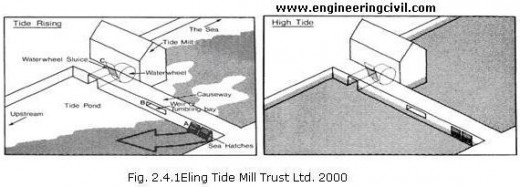
Letter A designates the sea hatches, or gates. B represents the Weir or Tumbling bay, which automatically maintains the head of water required to work the mill machinery. It can also act as a spillway for flood control. C corresponds to sluices that control the amount of water from the tide pond contracting the wheel.The picture below shows the Eling site, and each of the components for the tidal scheme.
The Eling Tide Mill provides an excellent example of how tidal scheme technology had remained unchanged for thousands of years.
2.4.1 From Milling to Electricity
In order to create enough electricity to be economically feasible, the size and configuration of the structure has to be increased tremendously. Tidal Energy consists of generating kinetic energy from potential energy. If falling water is forced through ducts with rotators attached to them, the rotors will turn driving electric generators (Mc Gown 182). Generating electricity from tides is very similar to hydroelectric generation, except the tides flow in two directions rather than one. For tidal power, the most common generating system is the ebb generating system. In the scheme, a dam, or barrage is constructed across an estuary. The tidal basin is allowed to fill when the sluice gates are opened and high tide is in. The gates are then closed when the tide turns trapping the water behind the gates. Once low tide is reached, the gates are opened the water flows through the turbines located underneath the water generating electricity. The basic concept for this type of scheme is extremely similar to that used at the Eling Mill. The schematic below shows the basic concept used in an ebb generation scheme.
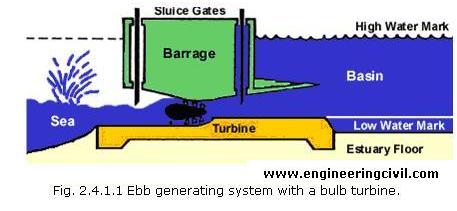
In some cases, double effect turbines are used, which are able to generate electricity when then basinis filling. In this scheme, sluice gates located on either side of the turbine are opened, when the tidal basin is low, and the sea is at high tide level. Water will rush into the tidal basin, turning the turbines and generating electricity. This occurs until the water level on either side of the barrage is equal. Atthis point, the sluice gates are closed until the sea is at its low tide height. When this occurs, the gates are opened and water flows from the basin to the sea, generating electricity a second time.
3. ADVANTAGES & DISADVANTAGES OF TIDAL ENERGY
3.1 Advantages
• It is an inexhaustible source of energy.
• Tidal energy is environment friendly energy and doesn’t produce greenhouse gases.
• As 71% of Earth’s surface is covered by water, there is scope to generate this energy on large scale.
• We can predict the rise and fall of tides as they follow cyclic fashion.
• Efficiency of tidal power is far greater as compared to coal, solar or wind energy. Its efficiency is around 80%.
• Although cost of construction of tidal power is high but maintenance costs are relatively low.
• Tidal Energy doesn’t require any kind of fuel to run.
• The life of tidal energy power plant is very long.
• The energy density of tidal energy is relatively higher than other renewable energy sources.
3.2 Disadvantages
• Cost of construction of tidal power plant is high.
• There are very few ideal locations for construction of plant and they too are localized to coastal regions only.
• Intensity of sea waves is unpredictable and there can be damage to power generation units.
4.0 CONCLUSION
The evolution of tidal energy from a primitive means of grinding grain, to a power stationgenerating over 8,000 megawatts is fascinating. Today it is sufficient to say that in most parts of America electricity is almost a basic human need. In the future we look to renewable energy for a means of providing us with energy, as well as not damaging the air and water that we need for survival. Tidal energy can offer this, but only if we are willing to pay the price for a clean environment.
REFERENCES
• American Fisheries Society. “Tidal Power Development in Estuarine and Marine Environments”. http://www.fisheries.org/resource/page15.htm
• Eling Tide Mill Trust Ltd. 2000, “Eling Tide Mill” (Online) Available: http://www.eling.aaugonline.net/sitem.html
• Renewable Energy: Sources for Fuel and Electricity. Island Press. Washington D.C. 1993.
• “La Rance Tidal Barrage”. (Online) Available: http://www.esru.strath.ac.uk/EandE/Web_sites/01-02/RE_info/tidal1.htm
• United States. Cong. Senate. Committee on Environment and Public Works. The Effects of the Proposed Tidal Hydroelectric Project in the Bay of Fundy. 98th Cong., 1st sess. S. Hrg 98-233. Washington: GPO, 1983.
• White, Frank M. Fluid Mechanics. 4th ed. Boston: McGraw-Hill Inc., 1999.
We at engineeringcivil.com are thankful to Prof. A. R. Ghode and Mr.Kukkar Paresh K for submitting their paper on “Tidal Energy Harvesting”to us. We are sure this will be of great help to those seeking more information about how to harvest energy from Tidal Energy.
If you have a query, you can ask a question here.


